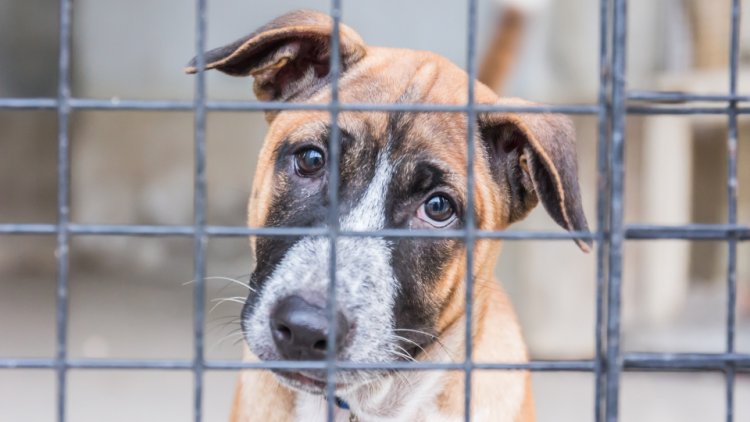Distemper is a highly contagious and often fatal disease that affects the respiratory, nervous, and gastrointestinal systems of dogs and puppies. Although distemper can spread quickly from one dog to another through sneezing and coughing, it is also very much preventable.
Keep reading to learn about the symptoms of canine distemper, the treatment options available, and what you can do to prevent your dog from contracting the disease.
Table of Contents:
- What is distemper in dogs?
- What causes distemper in dogs?
- Is distemper in dogs contagious to humans?
- What are the symptoms of distemper in dogs?
- How to diagnose distemper in dogs
- What is the treatment for distemper in dogs?
- How to avoid distemper in dogs
- Key Takeaways
Pro Tip: Vaccinations are essential to protect your dog from distemper. Pet insurance can help you cover costs for vaccinations and annual exams.
What is distemper in dogs?
Distemper is an incurable, highly contagious, and often fatal viral disease. It is multisystemic, which means that it affects multiple systems in the dog’s body: the gastrointestinal, nervous, and respiratory systems.
What causes distemper in dogs?
The disease is caused by the canine distemper virus (paramyxovirus virus or CDV) and
spread mainly through respiratory secretions. When an infected dog sneezes or coughs, they can easily infect any animals that are nearby. Their respiratory particulates can also infect nearby surfaces like bowls, supplies, and equipment, which makes the risk of exposure even higher.
Animals can also get infected from contact with infected urine, blood, or saliva. Female dogs can also transmit the distemper virus through the placenta to their puppies.
Dogs infected with distemper can shed the virus for up to several months. Canine distemper can occur throughout the year, but the majority of cases in domestic dogs seem to occur in the fall or winter as the virus is resistant to cold. The good news is the virus doesn’t survive long in the environment and can be easily destroyed by most disinfectants.
Is distemper in dogs contagious to humans?
There is no evidence that humans can contract canine distemper. However, as mentioned earlier, it also affects some wild animals like ferrets, raccoons, skunks, minks, wolves, coyotes, and foxes. Pet ferrets should be vaccinated against the disease using a USDA-approved ferret vaccine.
Dogs of any age can contract distemper but puppies younger than four months and dogs that haven’t been vaccinated against the disease are at an increased risk. Dogs in shelters might also be vulnerable since their vaccinations might not be up to date.

What are the symptoms of distemper in dogs?
Dogs with distemper can show a wide range of clinical signs depending on how advanced the disease is. One of the first symptoms is yellow-green discharge from the eyes, followed by:
- Coughing
- Nasal discharge
- Fever
- Vomiting
- Diarrhea
- Lethargy
- Depression
- Decreased appetite
- Anorexia
- Inflammation of the brain and spinal cord
Dogs infected with distemper can also suffer from secondary bacterial infections that attack when their immune systems are compromised by the distemper virus. These infections can cause gastrointestinal and respiratory symptoms such as diarrhea, vomiting, difficulty breathing, and pneumonia.
Some dogs can also develop crusting of the nose and footpads (hyperkeratosis). This symptom causes the footpads to enlarge and harden, making the pup very uncomfortable.
As the distemper progresses and starts affecting the nervous system, the infected dog will start experiencing neurological symptoms, including tremors, seizures, circling, head tilt, full or partial paralysis, muscle twitching, repetitive eye movements (nystagmus), excessive saliva, chewing-gum fits and sometimes even death.
How to diagnose distemper in dogs
Vets diagnose distemper based on the symptoms your dog is showing and laboratory testing.
Sometimes symptoms of canine distemper don’t always appear immediately. The disease might be mistaken for other infections or viruses.
The veterinarian might run tests to rule out other conditions like leptospirosis, toxin poisoning, and contagious viral hepatitis. They might take nose, eye, or throat swabs, as well as urine or bone marrow samples to test for viral infection. The vet might also test blood for antibodies or take a biopsy of the paw pad for detection of viral DNA.
Be sure to contact your veterinarian if you notice any of the above-listed symptoms. Distemper in dogs is highly contagious and requires aggressive medical treatment. You should also visit the vet if you don’t know your pet’s vaccination history or if your pet has been exposed to other animals with distemper.

What is the treatment for distemper in dogs?
There is no cure for distemper in dogs. Once the disease is diagnosed, treatment typically consists of supportive care. Infected dogs are usually hospitalized and separated from other dogs in order to prevent the spread of infection.
Distemper can weaken the dog’s immune system, resulting in secondary bacterial infections, disseminated intravascular coagulation, septicemia, and even death. Such cases usually require IV fluid therapy in order to prevent dehydration, intravenous nutritional support, antibiotics, electrolytes, probiotics, gastrointestinal protectants, and anti-vomiting medications.
Dogs who have trouble breathing, chronic coughing, and/or severe pneumonia might require antiviral medications, oxygen therapy, and antibiotics. Dogs that suffer from seizures need to be hospitalized for monitoring and receive anti-seizure medications.
Pro Tip: If your canine companion ends up in hospital for a few days, the vet bills can really escalate, making it difficult to help them get back to good health. A pet insurance policy can cover a portion of the treatment cost for accidents and illnesses, as well as diagnostic testing, hospitalization, and surgery.
Prognosis and recovery
If you suspect your dog has distemper, take them to the vet immediately. Prompt and aggressive treatment might help your dog recover completely.
The length of infection and survival rate depends on the strength of the dog’s immune system, as well as the virus strain. Some cases can resolve in about ten days, while others might exhibit neurological signs for weeks or months afterward.
The disease is especially serious and often fatal in puppies, as they’re more susceptible to viral infections. Grown dogs can recover but often have permanent neurological disorders such as brain damage, nerve damage, jaw spasms, muscle twitching, and seizures. These symptoms might appear after recovery or later in life. In these cases, the veterinarian might prescribe anti-inflammatories, immune system medications, or steroids, but they are not always successful.
How to avoid distemper in dogs
Fortunately, canine distemper is easily preventable with timely vaccination.
Puppies are usually vaccinated starting at six weeks of age and at regular intervals until they’re 14 to 16 weeks old. Vaccination is repeated one year later, then at regular intervals. Avoid gaps in the immunization schedule and ensure that your pup’s distemper vaccinations are up to date.
As with other vaccines, the maternal antibodies can interfere with vaccines, so a puppy is considered fully protected only after they have received the final vaccine in the series.
Until then, be careful about socializing them with unknown dogs at dog parks, puppy classes, doggy daycare, and other places where dogs can congregate in order to reduce exposure to the virus.
The majority of pups don’t show any side effects from vaccination, but some might experience soreness and mild fever after getting the distemper shot. In some cases, allergic reactions can occur, which can manifest through diarrhea, vomiting, facial swelling, fever, and loss of appetite.
Talk to your vet about the appropriate vaccination schedule for your pet and about the risks involved with vaccination.
Key Takeaways
- Distemper is a contagious and often fatal disease caused by a virus that attacks the GI, nervous, and respiratory systems of dogs.
- As the virus progresses, it will attack the central nervous system, resulting in neurological symptoms like tremors and seizures.
- Vets diagnose distemper in dogs through clinical appearance and laboratory testing. The disease is incurable and treatment typically consists of supportive care.
- Vaccination is crucial in preventing distemper in dogs.
